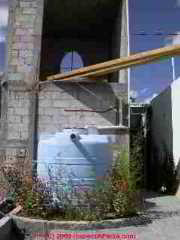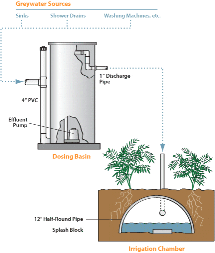 Alternative Water Sources for Lawns, Gardens, Orchards at Dry Sites
Alternative Water Sources for Lawns, Gardens, Orchards at Dry Sites
- POST a QUESTION or COMMENT about graywater systems & other water sources for non-potable water uses
Alternative sources of water for drinking, watering, or irrigation systems:
This article lists and compares the effectiveness of alternative sources of water for use on lawns, gardens, orchards, or for purification as drinking water - other than wells and municipal water supply systems. We also include links to greywater system references and books. Shown here is a clean design for onsite greywater disposal using a sketch from Clivus Multrum (see links below).
InspectAPedia tolerates no conflicts of interest. We have no relationship with advertisers, products, or services discussed at this website.
- Daniel Friedman, Publisher/Editor/Author - See WHO ARE WE?
Greenwater / Graywater / Rainwater Collection Alternative Water Sources - alternatives to using well water or municipal water for lawns, car washing, other non-potable water uses
 Just below we list products, systems, and designs used to conserve water, re-use or recycle water, reduce water use, or to store and re-use graywater. Links to in-depth articles about these products and systems are provided below.
Just below we list products, systems, and designs used to conserve water, re-use or recycle water, reduce water use, or to store and re-use graywater. Links to in-depth articles about these products and systems are provided below.
- CISTERNS have been used
since prehistoric time to collect and store rain water (rain water harvesting) or water from other sources. Modern cistern systems use concrete tanks, steel, fiberglass, plastic, or site built tanks to store water for re-use.
See WELLS CISTERNS & SPRINGS and see CISTERNS, WATER STORAGE. "Rain barrels" are mini-cisterns that are placed at the ends of downspouts. Cisterns are much larger containers, closed or open-topped, and located above-ground or under-ground. Cisterns or rain tanks are often designed to contain several thousand gallons of water at residential properties. Pre-1900 homes often included a stone or masonry cistern in the building's basement. - Composting Toilets
reduce water consumption by using little or no water from the building water supply.
See ALTERNATIVE & WATERLESS TOILETS and Composting Toilets. - Conservation of water
is an important part of any discussion of producing water for lawns, plants, etc. We introduce water conservation with respect to watering lawns
at PLANTING & LANDSCAPING to CONSERVE WATER. WATER QUANTITY USAGE TABLES Home & Outdoor Living Water Quantity Requirements, provides a table of daily residential water usage.
Waterless & Low Water Septic Systems, discusses chemical toilets, composting toilets, greywater systems, holding tanks, incinerating toilets. - DRINKING WATER EMERGENCY SOURCES discusses emergency sources of drinking water, such as how to find potable water in a disaster area after flooding, a hurricane, fire, or earthquake.
- Drywells
are used to simply dispose of un-wanted graywater on-site without provision for re-use of the water, that is wastewater is disposed into the soil without provision for water storage or water re-use.
See DRYWELL DESIGN & USES. - Filters for Greywater are installed at a laundry sink, clothes washer, or at the outlet of
a wastewater tank to filter water for re-use. S
ee Filters for Septic Tanks & Graywater to protect septic drainfields and reduce drainfield clogging. - Graywater Irrigation Systems or drip irrigation systems make use of (usually filtered) greywater
to provide water to lawns, plants, or crops.
See GREYWATER SYSTEMS. - Low Water Toilets or Low Flush Toilets
conserve water by using only a small amount of water to achieve the flush cycle. Low-Water or Low-Flush toilets work well partnered with graywater systems to both conserve and re-use water.
See TOILET ALTERNATIVES. - Rainwater Collection Systems provide alternative water supply for use in flushing toilets or
irrigating crops, lawns, or plants. Rainwater collection relieves the load on the potable water supply whether it's from a
local well or from municipal supply piping. r
ainwater collection systems range from a simple "rain barrel" to collect roof runoff, to very large cisterns which store water for onsite use during dry seasons or droughts.
Examples are
at CISTERN & RAINWATER COLLECTION SYSTEMS
and
at PASSIVE SOLAR HOME, LOW COST. - Septic system diagnosis, repair, maintenance:
even conventional drainfields, may provide moisture for lawns and certain other plants, but planting over a septic drainfield can also destroy it -
see PLANTS & TREES OVER SEPTIC SYSTEMS trees, shrubs, gardens, groundcover over or near the septic system: what can you plant over or near septic system components without causing a problem?
WASTEWATER TREATMENT BASICS escribes the different levels of treatment of septic wastewater that occur in typical residential systems.
Highly-treated (95% or better) septic effluent produced by some aerobic septic systems can be sprayed directly onto a lawn surface for watering grass.
See AEROBIC SEPTIC SYSTEMS, ATUs.
We do not recommend distribution of conventional septic system (tank and drainfield) minimally-treated septic effluent (less than 95%) onto gardens or orchards producing food products without first checking with your local health department. - Site contouring, landscaping, water runoff control
are used to slow the movement of rainwater over hard or rocky soils to allow time for water to soak into the ground where it both nourishes plants and may also replenish the local aquifer feeding local wells. - Waterless Toilets
conserve water by using no water to achieve the toilet flush cycle. Like composting toilets (see above), waterless toilets work well partnered with graywater systems to conserve water. Waterless toilets include incinerating toilet models
(see links listed at the ARTICLE INDEX the bottom of this article for more about alternative toilet products & designs.)
See TOILET ALTERNATIVES.
A Comparison of Alternative Methods for Obtaining Water for Use on Lawns, Gardens, Orchards, or for Purification for Use as Potable Drinking Water Supply
Can I Use Water Condensed from the Air to Obtain Additional Water Supply ?
 Several readers asked about the design and installation of equipment useful to obtain additional water supply by condensing moisture out of the air.
Several readers asked about the design and installation of equipment useful to obtain additional water supply by condensing moisture out of the air.
Watch out: the short answer is yes ... and no. You can indeed collect and re-use water condensed from air, but in typical air conditioning and dehumidifier systems additional steps are needed before such water can be made safe for drinking, cooking, and possibly even for washing.
Local Humidity Determines the Potential for Water Condensation
Start by calculating what is actually possible to obtain in times when there is no rain - by looking at the average humidity and relative humidity in your area over the year - that will tell you what is available in the air. The dew point (Tdp) is the temperature at which water vapor just starts to condense out of air that is cooling.
See DEW POINT TABLE - CONDENSATION POINT GUIDE. This psychrometric chart shows the relationship among temperature, relative humidity, and dew point. You will need to find data on local average humidity levels for your area.
Efficiency of water condensation methods
Continue by looking at the efficiency of methods of condensing water out of air, such as solar powered, gas powered, electricity powered condensers such as a dehumidifier - that's the obvious place to start as the technology already is developed and widespread.
Operating cost of water condensation:
Look at the cost of the equipment, the delivery rate of water per day, and the operating cost in electricity or gas per day, and you can calculate, combined with the first data (humidity) the cost of obtaining water by this method.
We suspect that in normal conditions (excluding the Space Station) the economics of using electrical or gas powered dehumidifiers or other water condensation systems simply does not work.
Watch out: for serious bacterial and other contaminants in condensate produced by HVAC systems and dehumidifiers.
See Legionella BACTERIA & HVAC EQUIPMENT - CLEANING & Legionella BACTERIA -
Rainwater Collection Methods to Obtain Additional Water Supply
You may find that you are better off providing a large cistern type storage tank. Use of large water storage cisterns has been a common practice for thousands of years and continues in modern use with plastic or fiberglass water storage tanks into which rainwater or in some areas even surface runoff may be channeled for future use.
See the rainwater collection and storage tank we show in our article
at PASSIVE SOLAR HOME, LOW COST) and collecting as much rainwater as possible when rainy weather occurs.
Graywater Collection Methods to Obtain Additional Water Supply
What many people do to obtain additional water for lawns, gardens, shrubs, and orchards , as you will see in our article above, is make use of graywater, usually filtered, sometimes treated.
Grey water is wastewater which does not contain sewage, typically coming from building sinks, showers, and laundry facilities.
Graywater systems can reduce the load on or size of a septic system, and gray water separation, filtration, storage, and piping systems can conserve water, for recycling for various uses such as flushing toilets, landscaping, or irrigation.
This article describes alternative graywater systems and designs, lists gray water (or grey water) products and suppliers, and compares products, models, and features. Other greywater systems include incineration and alternative greywater disposal methods.
You might find that rainwater collection in areas where rainfall is plentiful in some seasons, or graywater use, are more economical for your use, and that condensation is more costly to operate and less productive in quantity unless you design a cheap, very large solar condensing operation.
- See GREYWATER SYSTEMS
- See FILTERS SEPTIC & GREYWATER for graywater filters used to protect septic systems from debris in graywater, the first step in making graywater useful for watering grass, trees, plants, etc.
- See GREYWATER SYSTEM BOOKS for books on graywater systems
Aerobic Septic System Effluent for Watering Lawns
In Texas and other parts of the U.S. treated septic effluent (95% treated or better) is distributed on lawns by a spray system.
Planting and Landscaping to Conserve Water

A smart alternative to insisting on growing green grassy lawns in dry desert areas (Arizona, Nevada, similar areas) is planting and landscaping in naturally occurring plants and surfaces.
Our photo (left) shows a home near Phoenix, Arizona (Surprise) where landscaping is confined to plants that grow naturally in the area and thus plants with a low water requirement.
...
Continue reading at SPRINGS as WATER SUPPLY or select a topic from the closely-related articles below, or see the complete ARTICLE INDEX.
Or see these
Recommended articles
- CISTERN & RAINWATER COLLECTION SYSTEMS
- WATER CONSERVATION MEASURES - home
- WATER QUANTITY IMPROVEMENT
Suggested citation for this web page
WATER SOURCE ALTERNATIVES at InspectApedia.com - online encyclopedia of building & environmental inspection, testing, diagnosis, repair, & problem prevention advice.
Or see this
INDEX to RELATED ARTICLES: ARTICLE INDEX to WATER SUPPLY, PUMPS TANKS WELLS
Or use the SEARCH BOX found below to Ask a Question or Search InspectApedia
Ask a Question or Search InspectApedia
Questions & answers or comments about graywater systems & other water sources for non-potable water uses.
Try the search box just below, or if you prefer, post a question or comment in the Comments box below and we will respond promptly.
Search the InspectApedia website
Note: appearance of your Comment below may be delayed: if your comment contains an image, photograph, web link, or text that looks to the software as if it might be a web link, your posting will appear after it has been approved by a moderator. Apologies for the delay.
Only one image can be added per comment but you can post as many comments, and therefore images, as you like.
You will not receive a notification when a response to your question has been posted.
Please bookmark this page to make it easy for you to check back for our response.
IF above you see "Comment Form is loading comments..." then COMMENT BOX - countable.ca / bawkbox.com IS NOT WORKING.
In any case you are welcome to send an email directly to us at InspectApedia.com at editor@inspectApedia.com
We'll reply to you directly. Please help us help you by noting, in your email, the URL of the InspectApedia page where you wanted to comment.
Citations & References
In addition to any citations in the article above, a full list is available on request.
- Access Water Energy, PO Box 2061, Moorabbin, VIC 3189, Australia, Tel: 1300 797 758, email: sales@accesswater.com.au Website: http://www.accesswater.com.au/
Moorabbin Office: Kingston Trade Centre, 100 Cochranes Rd, Moorabbin, VIC 3189
Australian supplier of: Greywater systems, Solar power to grid packages, Edwards solar systems, Vulcan compact solar systems, water & solar system pumps & controls, and a wide rage of above ground & under ground water storage tanks: concrete, steel, plastic, modular, and bladder storage tanks. - Our recommended books about building & mechanical systems design, inspection, problem diagnosis, and repair, and about indoor environment and IAQ testing, diagnosis, and cleanup are at the InspectAPedia Bookstore. Also see our Book Reviews - InspectAPedia.
- In addition to citations & references found in this article, see the research citations given at the end of the related articles found at our suggested
CONTINUE READING or RECOMMENDED ARTICLES.
- In addition to citations & references found in this article, see the research citations given at the end of the related articles found at our suggested
CONTINUE READING or RECOMMENDED ARTICLES.
- Carson, Dunlop & Associates Ltd., 120 Carlton Street Suite 407, Toronto ON M5A 4K2. Tel: (416) 964-9415 1-800-268-7070 Email: info@carsondunlop.com. Alan Carson is a past president of ASHI, the American Society of Home Inspectors.
Thanks to Alan Carson and Bob Dunlop, for permission for InspectAPedia to use text excerpts from The HOME REFERENCE BOOK - the Encyclopedia of Homes and to use illustrations from The ILLUSTRATED HOME .
Carson Dunlop Associates provides extensive home inspection education and report writing material. In gratitude we provide links to tsome Carson Dunlop Associates products and services.

